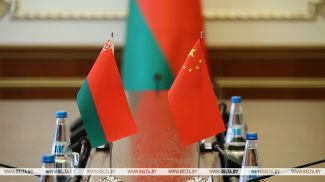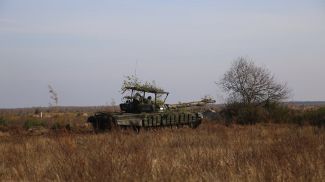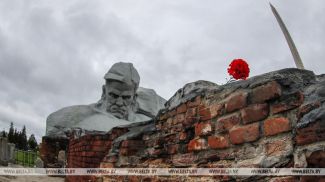The preparation for the Belarusian offensive started in spring 1944. The Supreme Command General Headquarters developed the plan of the operation taking into consideration the military and political situation and proposals of the frontline military councils. After a thorough discussion of the plan on 22-23 May the Supreme Command General Headquarters made the final decision to launch the strategic offensive on 22 June 1944, which was the third anniversary of the Nazi invasion of the Soviet Union.
As of 22 June 1944, the 1,100km frontline ran through Lake Neshcherdo to the east of Vitebsk, Orsha, Mogilev, Zhlobin and along the Pripyat River forming a big ledge. The Nazi Army Group Center was located there. It had a well-developed network of railways and motorways which enabled their maneuverability. The Nazi forces organized defense in depth (250-270km) which relied on a broad network of field fortifications and the terrain line. As a rule, defense facilities were located on western banks of numerous rivers.
The Belarusian offensive codenamed Operation Bagration started on 23 June 1944 and ended on 29 August 1944. The offensive aimed to strike simultaneously on six locations breaching the defense line and splitting the enemy forces. Later the Red Army was to attack Nazi troops near Minsk, encircle and destroy major enemy forces to the east of the Belarusian capital. The offensive was expected to proceed to the borders of Poland and East Prussia.
Operation Bagration was developed and carried out by distinguished Soviet commanders. The offensive plan was worked out by Army General Alexei Antonov. The main forces were led by Army Generals Konstantin Rokossovsky and Ivan Bagramyan, Colonel Generals Ivan Chernyakhovsky and Georgy Zakharov. The actions of the fronts were coordinated by representatives of the Supreme Command General Headquarters Marshals of the Soviet Union Georgy Zhukov and Alexander Vasilevsky.
Partaking in the battles were the 1st Baltic Front, the 1st Belarusian Front, the 2nd Belarusian Front and the 3rd Belarusian Front comprising 17 armies, including one tank army and three air armies, four tank corps and two Caucasian corps, a cavalry and a mechanized infantry group, the Dnieper military fleet, the 1st Polish Army and Belarusian partisans. During the offensive partisans intercepted the retreat of the enemy, secured existing bridges and built new ones for the Red Army, liberated a number of district capitals, took part in the elimination of surrounded enemy troops.
The operation consisted of two stages. The first stage held from 23 June to 4 July included the Vitebsk-Orsha Offensive, Mogilev Offensive, Bobruisk Offensive, Polotsk Offensive, and Minsk Offensive. During the first stage of the Belarusian operation the Soviet Army defeated the main forces of the Army Group Center. The second stage held from 5 July to 29 August included the Vilnius Offensive, Bialystok Offensive, Lublin-Brest Offensive, Siauliai Offensive and Kaunas Offensive.
On 23 June 1944 the Red Army liberated Sirotino District (Shumilino District from 1961). The 1st Baltic Front and the 3rd Belarusian Front surrounded five Nazi divisions to the west of Vitebsk by 25 June and eliminated them by 27 June. The main forces of the front occupied Lepel on 28 June. The 3rd Belarusian Front continued the offensive and liberated Borisov on 1 July. The 2nd Belarusian Front disrupted the enemy's defenses on the rivers Pronya, Basya and Dnieper and liberated Mogilev on 28 June. By 27 June armies of the 1st Belarusian Front surrounded six Nazi divisions near Bobruisk and destroyed them by 29 June. The frontline was moved to Svisloch, Osipovichi, Starye Dorogi.
The Red Army liberated Minsk as part of the Minsk Offensive on 3 July. Forces of the 4th and 9th Nazi armies (over 100,000 people) were besieged to the east of the city. The 1st Baltic Front liberated Polotsk during the Polotsk Offensive and moved to Siauliai. During 12 days the Soviet troops advanced 225-280km. They covered up to 20-25km per day. They managed to liberate a major part of Belarus. The Nazi Army Group Center suffered a catastrophic defeat. Its main forces were surrounded and cut to pieces.
The Soviet troops advanced to Polotsk, Lake Naroch, and Molodechno. They took over the territory to the north of Nesvizh. There was a 400km gap in the strategic front of the enemy. The attempts of the Nazi Army to fill the gap with separate divisions did not make a difference. The Soviet Army got an opportunity to defeat the remaining enemy forces. After the first stage of the operation was completed, the Supreme Command General Headquarters gave new instructions to the fronts to continue the all-out offensive to the west.
The Belarusian operation resulted in the complete destruction of 17 divisions and three brigades of the enemy. Some 50 divisions lost nearly a half of soldiers. About 500,000 Nazis were killed, wounded or captured. During Operation Bagration the Red Army liberated Belarus, freed part of Lithuania and Latvia. They came to Poland on 20 July and approached the borders of East Prussia on 17 August. By 29 August the Soviet troops reached the Vistula River and organized defense there.
The Belarusian operation created preconditions for the offensive on Germany. More than 1,500 participants of the operation were awarded the Hero of the Soviet Union title, over 400,000 soldiers and officers received orders and medals, 662 units were given honor titles after the towns and districts they liberated.
As of 22 June 1944, the 1,100km frontline ran through Lake Neshcherdo to the east of Vitebsk, Orsha, Mogilev, Zhlobin and along the Pripyat River forming a big ledge. The Nazi Army Group Center was located there. It had a well-developed network of railways and motorways which enabled their maneuverability. The Nazi forces organized defense in depth (250-270km) which relied on a broad network of field fortifications and the terrain line. As a rule, defense facilities were located on western banks of numerous rivers.
The Belarusian offensive codenamed Operation Bagration started on 23 June 1944 and ended on 29 August 1944. The offensive aimed to strike simultaneously on six locations breaching the defense line and splitting the enemy forces. Later the Red Army was to attack Nazi troops near Minsk, encircle and destroy major enemy forces to the east of the Belarusian capital. The offensive was expected to proceed to the borders of Poland and East Prussia.
Operation Bagration was developed and carried out by distinguished Soviet commanders. The offensive plan was worked out by Army General Alexei Antonov. The main forces were led by Army Generals Konstantin Rokossovsky and Ivan Bagramyan, Colonel Generals Ivan Chernyakhovsky and Georgy Zakharov. The actions of the fronts were coordinated by representatives of the Supreme Command General Headquarters Marshals of the Soviet Union Georgy Zhukov and Alexander Vasilevsky.
Partaking in the battles were the 1st Baltic Front, the 1st Belarusian Front, the 2nd Belarusian Front and the 3rd Belarusian Front comprising 17 armies, including one tank army and three air armies, four tank corps and two Caucasian corps, a cavalry and a mechanized infantry group, the Dnieper military fleet, the 1st Polish Army and Belarusian partisans. During the offensive partisans intercepted the retreat of the enemy, secured existing bridges and built new ones for the Red Army, liberated a number of district capitals, took part in the elimination of surrounded enemy troops.
The operation consisted of two stages. The first stage held from 23 June to 4 July included the Vitebsk-Orsha Offensive, Mogilev Offensive, Bobruisk Offensive, Polotsk Offensive, and Minsk Offensive. During the first stage of the Belarusian operation the Soviet Army defeated the main forces of the Army Group Center. The second stage held from 5 July to 29 August included the Vilnius Offensive, Bialystok Offensive, Lublin-Brest Offensive, Siauliai Offensive and Kaunas Offensive.
On 23 June 1944 the Red Army liberated Sirotino District (Shumilino District from 1961). The 1st Baltic Front and the 3rd Belarusian Front surrounded five Nazi divisions to the west of Vitebsk by 25 June and eliminated them by 27 June. The main forces of the front occupied Lepel on 28 June. The 3rd Belarusian Front continued the offensive and liberated Borisov on 1 July. The 2nd Belarusian Front disrupted the enemy's defenses on the rivers Pronya, Basya and Dnieper and liberated Mogilev on 28 June. By 27 June armies of the 1st Belarusian Front surrounded six Nazi divisions near Bobruisk and destroyed them by 29 June. The frontline was moved to Svisloch, Osipovichi, Starye Dorogi.
The Red Army liberated Minsk as part of the Minsk Offensive on 3 July. Forces of the 4th and 9th Nazi armies (over 100,000 people) were besieged to the east of the city. The 1st Baltic Front liberated Polotsk during the Polotsk Offensive and moved to Siauliai. During 12 days the Soviet troops advanced 225-280km. They covered up to 20-25km per day. They managed to liberate a major part of Belarus. The Nazi Army Group Center suffered a catastrophic defeat. Its main forces were surrounded and cut to pieces.
The Soviet troops advanced to Polotsk, Lake Naroch, and Molodechno. They took over the territory to the north of Nesvizh. There was a 400km gap in the strategic front of the enemy. The attempts of the Nazi Army to fill the gap with separate divisions did not make a difference. The Soviet Army got an opportunity to defeat the remaining enemy forces. After the first stage of the operation was completed, the Supreme Command General Headquarters gave new instructions to the fronts to continue the all-out offensive to the west.
The Belarusian operation resulted in the complete destruction of 17 divisions and three brigades of the enemy. Some 50 divisions lost nearly a half of soldiers. About 500,000 Nazis were killed, wounded or captured. During Operation Bagration the Red Army liberated Belarus, freed part of Lithuania and Latvia. They came to Poland on 20 July and approached the borders of East Prussia on 17 August. By 29 August the Soviet troops reached the Vistula River and organized defense there.
The Belarusian operation created preconditions for the offensive on Germany. More than 1,500 participants of the operation were awarded the Hero of the Soviet Union title, over 400,000 soldiers and officers received orders and medals, 662 units were given honor titles after the towns and districts they liberated.













